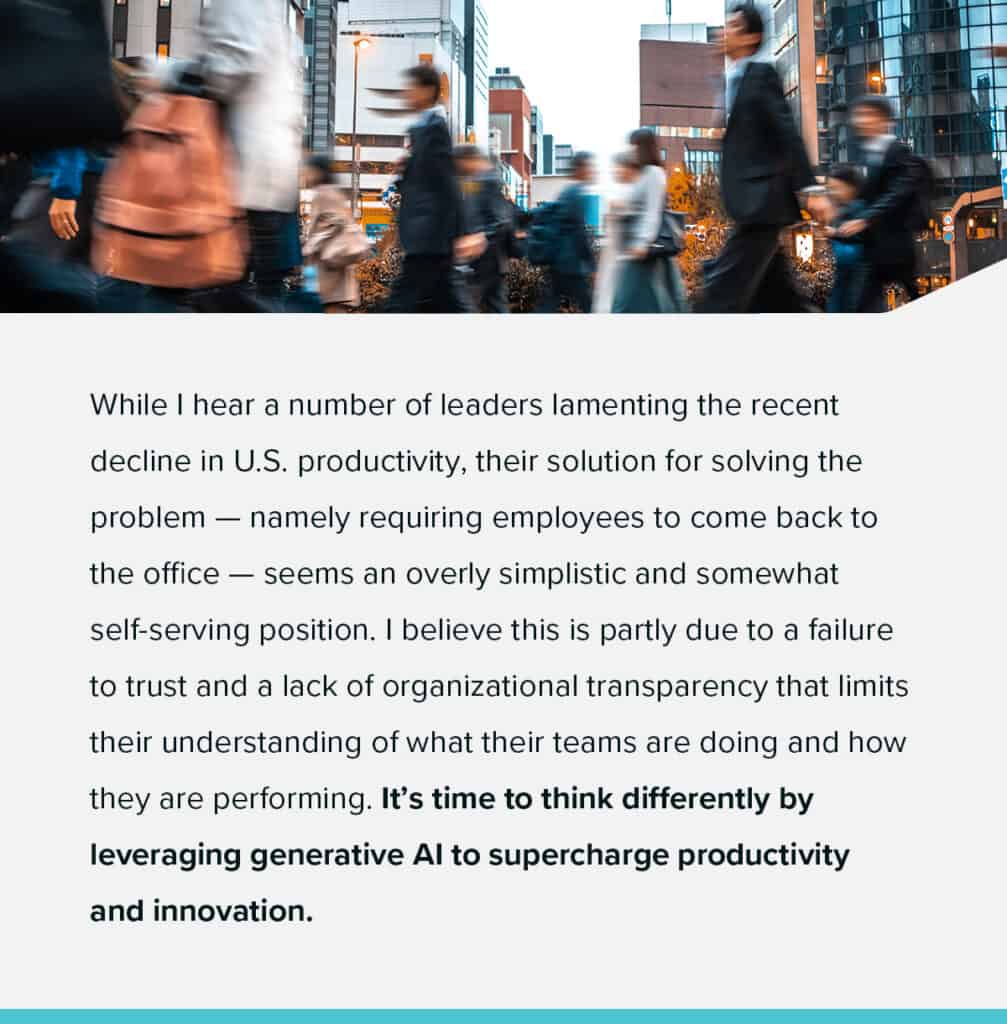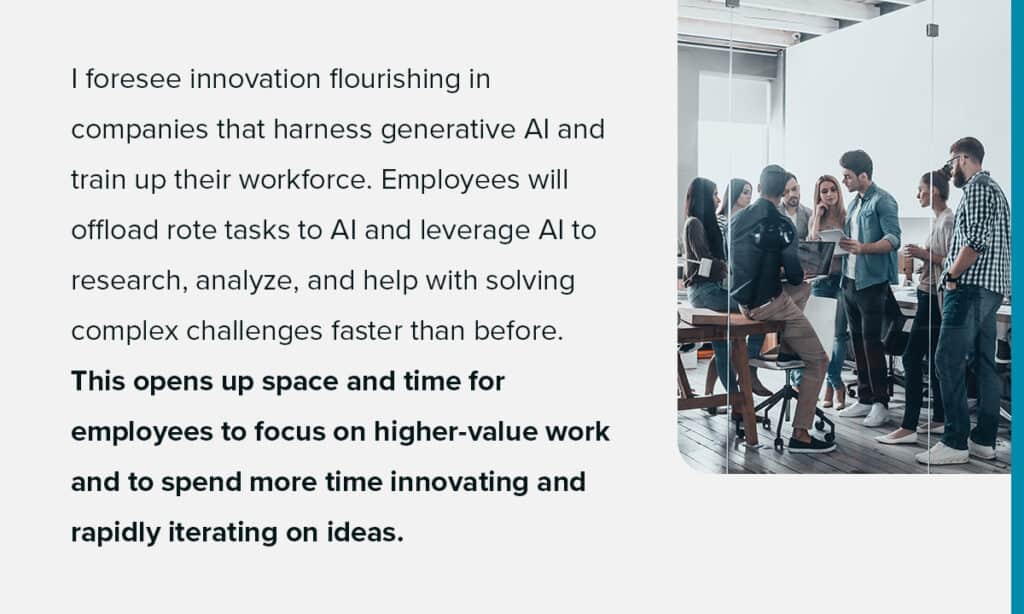We all know that work and employee sentiments about work have taken a 180-degree turn in the past few years. While I hear a number of leaders lamenting the recent decline in U.S. productivity (it decreased 2.1% in the first quarter of 2023 according to the BLS, marking five consecutive quarters of decline), their solution for solving the problem — namely requiring employees to come back to the office — seems an overly simplistic and somewhat self-serving position. I believe this is partly due to a failure to trust and a lack of organizational transparency that limits their understanding of what their teams are doing and how they are performing. It’s time to think differently by leveraging generative AI to drive productivity and innovation.
The problem with the traditional approach is that forcing employees back to the office won’t solve the productivity dilemma and is not a solution employees will accept. There is a better way forward that can drive productivity and increase employee satisfaction and well-being. It involves shifting from broken performance management practices to performance enablement, increasing manager effectiveness and support, and using generative AI to deliver productivity gains and innovation. It’s the last one of these that I plan to focus on in this article.
Lower productivity is a symptom with many causes
Our own recent research shows that employees actually feel they are more productive this year than last. The Betterworks 2023 State of Performance Enablement report shows that people’s sense of their own productivity has risen eight percentage points this year to 67%, and their view of their discretionary effort (going above and beyond at work) has jumped 19 points to 60%.
How is it that employees gauge their own productivity so differently from the actual productivity numbers? In short, say economists, employees are working longer hours but their output has not kept pace, in turn yielding lower productivity.
But the reasons for lower productivity are complex. As others, like Gregory Daco, the chief economist at EY-Parthenon, and Zip Recruiter’s Chief Economist Julia Pollack have pointed out, the root causes are likely many and far more nuanced than employees taking advantage of working from home by taking a more leisurely pace and running errands, as some well-known CEOs have suggested.

Lower productivity is partly the result of job-hopping during the Great Resignation, and the ongoing labor shortage. It takes most employees three to six months to get up to full speed in their roles, but if they or their colleagues are continually churning, the productivity hits to a business will magnify.
The challenges of hybrid work arrangements are likely part of the mix, too, and we’re all still learning how to do hybrid work efficiently. How often should employees come into the office, for what activities, and how should they coordinate with their work teams for maximum productivity? Work is not a one-size-fits-all proposition.
Workers can also disengage if they feel communications are poor, which in turn leads to distrust, feeling isolated, and a lack of ownership in work. Companies need to rise to the occasion rather than blame their employees and point fingers at hybrid and remote work. It’s a new world for work and every organization must adapt.
The stress and burnout nearly everyone has encountered to some degree continue to take their toll, and wellness programs, as important as they are, are not solving the problem. Quiet quitting is just one example of people’s self-protection mechanisms kicking in. Frustration and ennui —a feeling that your efforts are futile — as Pollack points out, can have a lasting and damaging effect not only on workers but on businesses through declining innovation. Also, one of the reasons is poor technical support: not optimized, slow computers and lack of necessary applications. This can slow down the workflow. The solution to this lies on the surface: you need to install special software to optimize the operation of the device. Also, here are a few recommendations to follow if you want a fast and well-optimized computer.
The questions organizations should be asking are:
- Do your employees clearly understand what work needs to be done and by when?
- Do we have employees who are committed to their work, and if not, why? (The answer probably has to do with your culture, manager effectiveness, performance enablement approach, or some combination thereof.)
- Do we have systems in place that empower them to do their best?
- Does our culture reflect values that drive behaviors like trustworthiness, commitment, transparency, responsibility, kindness, and innovation?
- Are we supporting our managers to be effective leaders and coaches?
- How can we use generative AI to make our employees more productive?
Let’s look at the last question in greater detail.
AI will be a huge boost to productivity and innovation
People are increasingly worried about losing their jobs due to a recession and the downstream effects of inflation. We’ve seen the tech and financial services industries conducting large layoffs. Over time, there will be some jobs lost and many more upended due to AI. A recent World Economic Forum report stated that 25% of companies expect AI-related job losses. Similarly, Goldman Sachs has said 300 million jobs will be affected by AI, with the greatest impact in developed countries.
I take another perspective — looking at the potential upsides and with a longer time horizon. Yes, we will need to retrain and upskill people because the majority of workers will feel AI’s effects in some way, but the positive impact on productivity and innovation will be mind-blowing. A just-released report by McKinsey & Company finds that generative AI could add up to $4.4 trillion annually to the global economy, which is akin to adding a new country like Germany, with $4.3T in annual GDP, to the Earth.
We will need to retrain and upskill people because the majority of workers will feel AI’s effects in some way, but the positive impact on productivity and innovation will be mind-blowing.
Who will create value?
One of my employees recently asked me what I thought of Price’s Law, which is a derivative of the Pareto Principle (80% of the output is determined by 20% of the input, also commonly known as the 80/20 rule where 20% of the people do 80% of the work). Price’s Law says that the square root of the number of participants does 50% of the work. While this principle was derived initially from an analysis of classical music composers, it has been adopted across many disciplines.
In business, it means that in a 10,000-person company, 100 people create half of the output — the value. By that logic, it’s been argued that a company could let go of quite a few of its employees with no impact, or can focus development efforts primarily on high potentials.
I disagree on a few levels. While a company could remove 20% of its workforce, on average, without dampening productivity, letting go of 30% to 50% is cutting into the bone. And when companies have large-scale layoffs, how can they be certain that they’re not laying off key employees? Look at what happened at Twitter. This doesn’t take into account the damage to morale across the workforce and the lasting negative impacts on culture that affect measures such as engagement and productivity among remaining employees and the ability to attract the best talent. By focusing development efforts only on top talent, companies fail to tap into the full potential of all their employees, instill loyalty, and develop a talent pipeline that enables businesses to remain agile.
A just-released report by McKinsey & Company finds that generative AI could add up to $4.4 trillion annually to the global economy, which is akin to adding a new country like Germany, with $4.3T in annual GDP, to the Earth.
How AI will supercharge productivity
We need to view productivity through a new lens: generative AI. Depending upon the skill of an employee and the type of work they do, generative AI could make them several times faster and more efficient. A recent study by Stanford and MIT, limited in scope, showed an increase in productivity of up to 35%, depending upon the skill of the worker.
Imagine what might happen if employees learn how to harness generative AI so well that they can increase their productivity multiple times over. This is what Geoffrey Hinton, the “godfather of generative AI” believes. If you subscribe to the Pareto Principle or Price’s Law — that a small percentage of your workforce is absolutely indispensable and gets a serious amount of work done — and you increase their productivity tenfold by leveraging AI, you’re talking about a collective productivity increase of tens of thousands of percentage points just among that small group.
The question becomes, do you want to get 10 times more done with those star performers, or do you want to reduce the number of people you have by 10%? If you have the opportunity to make employees dramatically more productive with AI, the sensible option is to retain your people.
If you consider AI’s impact on the remainder of your workforce, you’re talking about serious productivity increases. AI will shift the bell curve to the right.
Creating space for more innovation
I foresee innovation flourishing in companies that harness generative AI and train up their workforce. Employees will offload rote tasks to AI and leverage AI to research, analyze, and help with solving complex challenges faster than before. This opens up space and time for employees to focus on higher-value work and to spend more time innovating and rapidly iterating on ideas.
At Betterworks, we’ve been using AI and machine learning for a while in our products to reduce bias, help managers provide and write high-quality feedback, and enable employees to set better objectives and key results (OKRs). More recently, we have made Chat GPT 4 and similar tools available to all our employees. I’ve made experimentation with generative AI a company focus, asking employees to find ways to use it to work with greater efficiency and to find optimal approaches to their work.
We share ideas for how to leverage ChatGPT internally, and we recently had an internal hackathon to brainstorm ideas for improving internal processes and our performance enablement solutions. Embedding generative AI throughout our solutions is core to our roadmap.

Be Bold
The evolution of how and where we work will continue to move full speed ahead. Insisting on holding onto the traditional ways of working limits the quality of talent an organization can hire and employee satisfaction and commitment. It promotes a mindset that will handcuff the ability to think about how to creatively approach novel work challenges. Unleashing productivity and innovation in employees starts with leadership.
Doug Dennerline is the CEO of Betterworks. He has been working in Silicon Valley since 1982 at companies including HP, 3Com, and Cisco, and massively scaling those companies. Doug was the president of SuccessFactors, which was the first company to move the performance management process to the cloud and was ultimately acquired by SAP. In his last role at Cisco, he became the CEO of Webex after the acquisition of Webex by Cisco. He has been running SaaS companies ever since.
How will AI make HR more productive?


